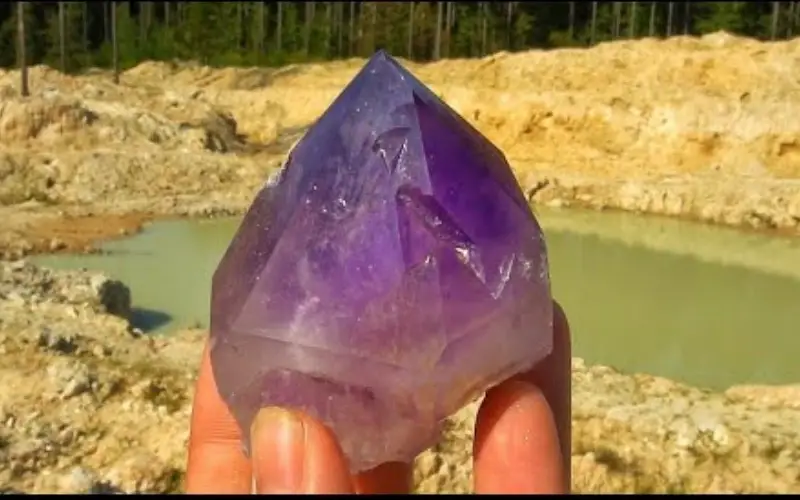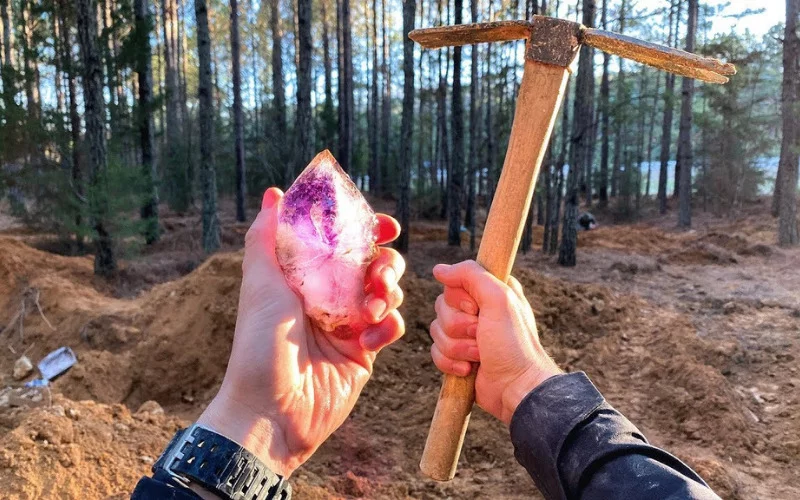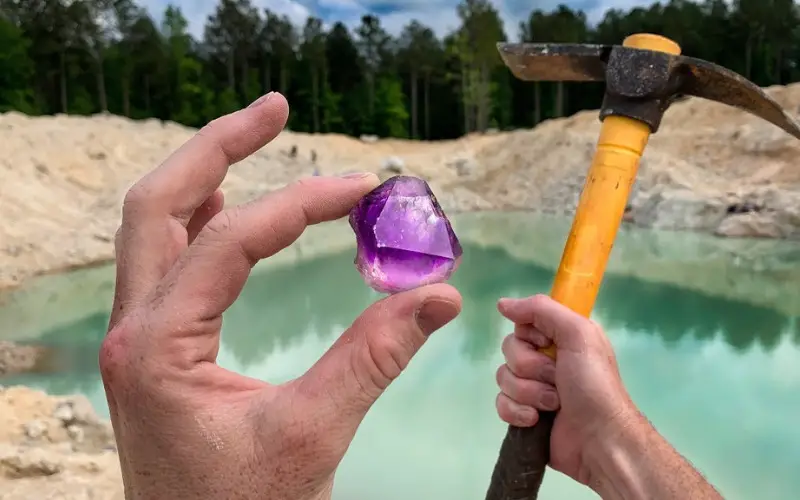It almost sounds ridiculous to think of finding something as precious as Amethyst in your backyard where you have vegetables growing, ponds splashing, and even compost going. But the truth is that you might find one if you search.
Many people don’t find gemstones around them not because they are not there but because they are not looking out for them.
Amethyst, like most gemstones, is mined off the ground, so there is no ruling out the fact that you might find one in your backyard.
What Really Is an Amethyst?

Amethyst is a gemstone that is crystallized quartz whose color can run from lilac to reddish-purple. The rich purple color of Amethyst is its distinctive characteristics and determines its quality.
These precious gems are a beauty to behold, and when they are found in huge rock geode, they can be quite breathtaking.
A rich medium violet color is the highest quality of the stone. The darker the shade, the less the quality because these dark shades of Amethyst seem to look black and plain under very bright light. While the lighter-colored stones don’t have the richness that makes an Amethyst what it is.
What Are the Traits of Amethyst?
- That beautiful purple color is the first characteristic that immediately draws people to this gem. Little wonder you will these gems used in decorating people’s homes and even public places.
- They can take on different colors depending on the polarization of the light, which makes them more alluring.
- They have a Moh’s hardness of 7. Geologists have a way of determining the hardness of material using Moh’s measurement. Do this value means that Amethyst is very hard, strong, durable, and hardly breaks by cleavage.
- When exposed to ultraviolet light or heat sources for a long period, they can lose their brightness. So, if you want your gem to remain bright and lustrous, then you might want to keep it away from the heat and ultraviolet rays of the sun.
What are Amethysts Used For?
Many people believe that there are many emotional, spiritual, and physical healing abilities inherent in this gem; some even say that you can drink all the booze you want without getting a drink when you wear this gem.
All we can say is that these beliefs have not been scientifically proven, so we cannot vouch for any one of them. There are; however, other uses that give Amethyst its value:
- They are piezoelectric materials which means they can convert mechanical energy into electrical energy. Hence, they are useful in making electronics like generators, televisions, microphones, and others.
- They are durable and used in making jewelry like bracelets, earrings, rings, pendants, and the likes.
- Their beauty gives them an aesthetic value so they can be used to beautify people’s homes and office spaces.
What Rock is an Amethyst Found in?
The naturally occurring Amethyst is found in quartz in Igneous and Metamorphic rocks. There are many rock geodes which are quartz with a hollow interior, and when these rock geodes are broken, then the gemstones Amethyst can be seen as that very beautiful purple-colored gemstone that can be seen in the hollow quartz.
Beholding the inside of the broken rock gives out a beauty that only nature can exude, and when these gemstones are extracted, cut, and polished, they can be put into many amazing uses.
We must also state here that synthetic Amethyst is produced in the laboratory with the same look and feel, but the value is not the same. The naturally occurring Amethyst has more value than the synthetic ones.
Can I find Amethyst in My backyard?
These purple beauties are not common in all places. For instance, in the US, North Carolina, Maine, Arizona, and Colorado are places where you stand a high chance of finding Amethyst in your backyard because they are commonly found in these places.
If you live in any of these locations, and your backyard is close to a river, stream, creeks, and rock geodes, then your chance of finding Amethyst in your garden is greatly increased.
Who knows, you might pick the first rock you see, notice that it is hollow and when you crack it open, and boom! You might find a fine amethyst gemstone staring you in the face.
Where is Amethyst Most Found?

Amethyst is found in large deposits in many locations globally, especially in South American Countries, Ontario, and is not so large in quantities in the US, Africa, Spain, and other countries. Most deposits are in cavities and fractures of Igneous and metamorphic rocks. Brazil is said to have the height deposit of this gem.
Can I Find Crystals in My Backyard?
To ascertain whether you can go digging for Amethyst or any other gem for that matter in your backyard, you must be sure that your region traditionally has some deposit of crystal in them.
If you are sure of this fact, the next thing to do is to analyze your landscape: if your backyard is surrounded by rocks, rivers, natural ponds, and the likes, then the possibility of finding crystals in your backyard is increased.
The common type of gemstones included: jade, opal, agate, tourmaline, and the likes.
Where can Amethyst be Found Naturally?
This gemstone is found in specific places in regions where they are abundant, like the Americas, USA, Africa, amongst others.
They are found underneath the soil surface, in gravels, or even in the rocks. Water bodies have a rich deposit of these stones like natural ponds, rivers, and lakes.
If you have a good deposit of limestone in your regions, you stand a higher chance of mining this stone. Check out creeks, rivers, or oceanside as they are the usual places to find Amethyst deposits.
Why is Amethyst so Cheap?
Before the 19th Century, Amethyst was included as one of the precious and valuable stones on the earth, together with Ruby, Diamond, Emerald, and Sapphire.
But since large quantities of this gem were discovered in different places worldwide, its value and even nomenclature have dropped.
This is simply the market forces of supply and demand at work: Things only have value to the degree to which they are relatively scarce; hence since the supply of Amethyst increased, its value dropped, and so did the price. Hence the cheapness of Amethyst is mostly because the stone is large supply globally.
How Can You Tell if a Rock is Amethyst?
It is possible to pick any stone that looks a shade of purple and then imagine that you have an Amethyst, it is also possible to go to a jewel store to buy a jewel that has Amethyst in it, and you do not want to be conned.
The following will tell you how to distinguish between an Amethyst and your everyday rock.
- The color of an Amethyst is its most distinguishing trait. If the stone is purple to a shade of violet, with some reddish undertone, then maybe that rock is an Amethyst.
- Check to see how clear the gem is to the eye; Amethyst is usually free of inclusions like bubbles and discoloration. The clearer the gem is to the eye, the more likely it is an Amethyst. There is other equipment that jewelers can use to detect inclusions in the jewel that might not be visible to the human eyes.
- Check the stone to see if there is a color variation. Most naturally occurring Amethyst have variations in colors, while those produced in the laboratory tend to have none of these color variations. So, if the gem’s color is homogeneous, it probably might be a synthetic Amethyst.
- To further distinguish a real Amethyst from a synthetic one, check the shape of the stone. Amethyst that has not being cut will have a slightly uneven shape, while synthetic ones tend to be perfectly shaped.
- Go for professional testing: a jeweler can test the specific gravity of your gem to determine what gem it is. The specific gravity of 2.65 means your stone is Amethyst.
The hardness of the stone can be checked, too, and if the hardness is 7, then the gemstone is most likely am Amethyst.
Is Amethyst More Expensive Than Diamonds?
The rarer a gemstone is, the more the value and the more expensive it is. Diamond and Amethyst used to be graded alike when they were both rare, but since the discovery of deposits of Amethyst in different parts of the world, its value has dropped to a fraction of what it used to be before.
Diamond, on the other hand, asides from the fact that it is rare and so is valueless, has other physical and structural characteristics that keep its value very high and hence expensive.
For one, it is a very hard stone; in fact, diamond is termed the hardest thing in the world, that is why it is said that only a diamond can cut a diamond.
Its lustre, its specific gravity, amongst others, are what set Diamond far above not only Amethyst but also other gemstones, So Amethyst is far less expensive than diamond.
Is Amethyst a Precious Stone?
Amethyst used to be a precious stone, but now it is considered a semi-precious stone. Only four stones in the true sense of it can be called precious stones in the world today, and they are Diamonds, Sapphire, Emerald, and Ruby.
Besides the fact that Amethyst became relatively abundant and lost its market value, geologists consider other factors in grading stones, including their physical characteristics like hardness, lustre, specific gravity, refractive index cleavage, and fracture, amongst others.
How are Amethysts Valued?
Like most gemstones, these four Cs determine the value of an Amethyst:
- Color: A rich medium purple Color is deemed the Amethyst of higher value. The deep Russian Amethyst has a beautiful color display that makes it one of the most expensive Amethysts in the world.
- The cut: when Amethyst occurs naturally with a round or value shape, they have more value than if they are of uneven shape. These oval or round-shaped stones can form the central gem of a jewel.
- The clarity: this has to do with the gem’s purity; obstructions in any gem lessen their value. The clearer and Amethyst are, the more valuable it is. Very vibrant Amethyst with unbroken specimens can fetch a good price in the market.
- The carat: the carat weight of an Amethyst also determines its value
Conclusion
Even though it might seem far-fetched to dig for Amethyst in your backyard, it is not entirely a fruitless venture because many of our backyards have good deposits of not just Amethyst but also other beautiful gemstones, and you will never know until you try some digging.
But ensure that your region is known for having a supply of these purple stones and that your backyards have streams, rivers, creeks, or even gravels and rocks around them since this increases your chances of mining them.
So, I say more, get a digger and a shovel and dig for some Amethyst. Who knows what you will find?
You May Also Like:
Hope this article helped you learn How To Find Amethyst in Your Backyard. You may also want to bookmark our article on Factors to Consider When Buying a Snowblower for Gravel Driveway.
I will love to hear from you if you have any other suggestions on How To Find Amethyst in Your Backyard, all you have to do is comment below and reach out to people by sharing this post on social media.
If you liked this article, then please follow us on Facebook, Instagram, and Pinterest.

